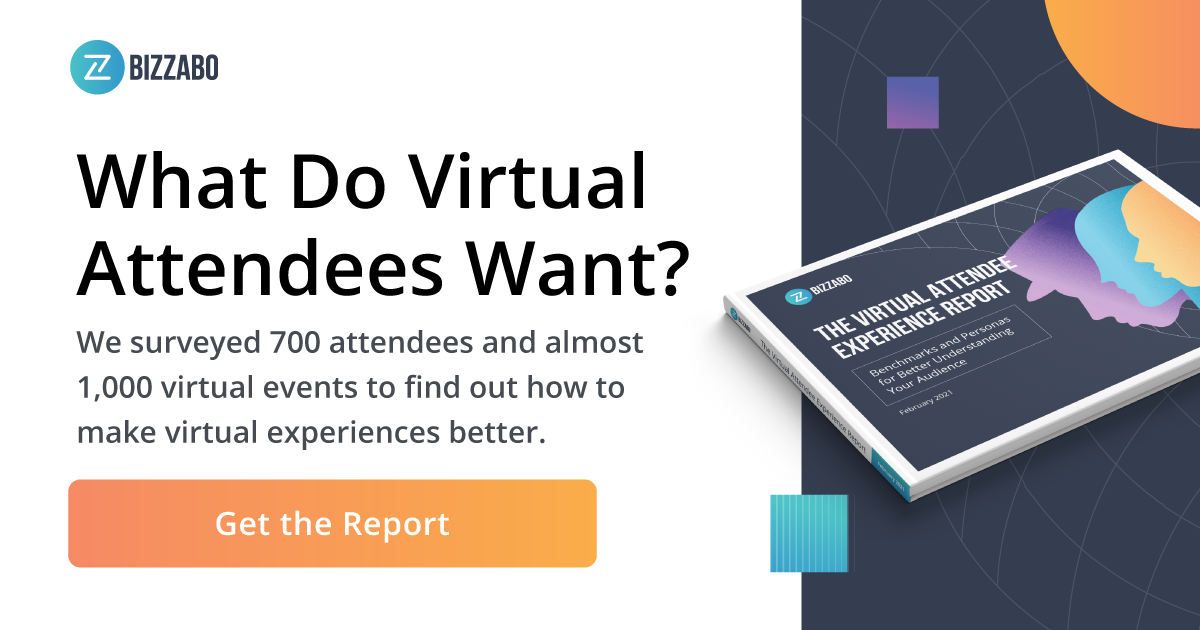Since in-person gatherings moved online, experts have been determining the best way to monetize virtual events. Apply advice from four leading event profs.
Virtual events have all but taken over the industry in the past year, and while expert predictions on hybrid note a potential shift coming in the near future, the time to monetize your virtual events is now.
Almost 75% of event and marketing professionals surveyed pivoted their events to virtual in response to COVID-19, but most organizers are still in the early stages of optimization.
Here are some best practices for monetization that have emerged since in-person events moved online, and how you can start integrating them today.
1. Don’t Treat Virtual as a Replacement for In-Person
Designing a valuable virtual event attendees will want to pay for starts with building trust that the experience will be worth it. For a virtual event to be successful, you can’t simply take a “lift and shift” approach; what worked in person won’t necessarily translate to your digital audience. Your virtual event ideas should reflect the nature of the medium through which they’re being delivered.
Attendees want to feel like they’re getting their money’s worth out of a virtual event, both in the content being presented and in the overall online experience. It will become increasingly difficult to monetize an event that feels careless and there is potential damage to your brand if you don’t deliver, says Marco Giberti, Founder of Vesuvio Ventures.
“Pay attention to setting the right expectations,” says Giberti. “A virtual event is not going to deliver a customer experience that is similar to a face-to-face event. It’s a different animal.”
One key difference you can have objective control over is the technology itself. “We focused on our video production quality to make sure that people felt, ‘Wow, this is thoughtful, detailed, high quality,’” says Kyle Suzuki, Head of XM Events for Qualtrics, who credits the success of his WorkDifferent event with that approach.
2. Think Outside the Box With Sponsors
Though event professionals are still finding their footing when it comes to virtually integrating sponsors, the concept of sponsorship remains as viable as ever when it comes to monetization. The key comes in reimagining the approach.
Just as “lift and shift” doesn’t work for planning your online event, virtual event sponsors need fresh takes on how to incorporate their brand in a way that doesn’t feel tacked on.
“Sponsors want to partner with us on an activation that is close to their hearts,” says Adele Durham, VP of Events for Haymarket Media. “You really have to home in on what they want to get out of the experience rather than just putting their logo on a step and repeat.”
For example, Durham says, just because your event is virtual doesn’t mean you can’t have an interactive, fun activation. She even dreamed up a virtual caricature artist that a sponsor could partner on.
Use this time to expand the parameters of how a sponsor can interact with your audience, and tailor it to their needs. Event professionals only report on average a confidence rating of 6.5 out of 10 when it comes to providing value to their event sponsors. Build your confidence by coming up with new ideas that serve both your sponsors and your audience.
3. Capture More Attendees at a Lower Price Point
While admission prices for virtual events are understandably lower, the potential for reach is the biggest positive shift organizers are experiencing. And because virtual event budgeting leaves more wiggle room, finding the pricing sweet spot could get you back in the black.
The average cost of a virtual event is 45% less than an in-person event, however prices slowly raised over 2020 as marketers tested the waters of what attendees considered fair. This resulted in an average cost of $443 per virtual event in the last six months of 2020. Knowing this and other virtual event benchmarks can help guide you in your pricing structure.
If you’re more comfortable charging less for what you know you’re able to offer online, know that people are attending more online events than they used to attend in person—with a 34% increase in attending 10 or more online events annually.
“The barrier to entry for participation is much lower,” says Kyle Suzuki of Qualtrics. “Instead of buying a pass, taking time off from work and family, getting on an airplane, you can attend from the comfort of your own home.”
The more flexible you’re able to be for your audience, the better chance you’ll have of attracting the right people to your brand. And as we look towards the hybrid future, attracting eyeballs at almost any virtual price point could pay off in the long run. “Show them that there are can’t-miss opportunities to continue to help them grow by coming to the physical event,” says Stacey Gromlich, Director of Audience Engagement and Global Events for Siemens.
4. Create Tiered Experience Packages
One way to engage those more willing to eventually attend an in-person event is with different levels of experience. While free admission for virtual events was the norm at the beginning of the pandemic, check-in rates are 21% lower for free events, resulting in lower engagement overall.
That’s not to say that limited duration free admission isn’t a great idea, especially when it comes to gaining that reach and expanding your audience and your brand recognition. But since check-in rates increase with ticket prices, you’ll be able to capture the attention of the right people by adopting a tiered approach.
Consider making certain aspects of the content available only to digital subscribers, or enhance the ability to network online (a persistent issue in the virtual sphere) for those who pay for the privilege.
“Maybe there’s a green room,” says Adele Durham. “Do you have a hosted conversation or webcast with the speaker that’s just come off stage and the digital subscribers get access to that because the live attendees are now in another session?”
Those kinds of exclusive options will engender loyalty with a virtual audience that you might one day see at a live event.
5. Extend Your Virtual Event Timeline
Moving online means breaking all the rules, so who says your virtual event only needs to last a few days? Building an extended campaign around your event can maximize audience engagement long before and after the big production.
This approach could be the culmination of all the above steps—from tailoring your event to the medium, creating more value for your sponsors, capturing a wider audience, and creating a tiered experience. All of this is possible when you view your event less as a one- or two-day affair and more as an ongoing experience.
“I don’t think that events should be positioned as a two or three days experience only,” says Marco Giberti. “Now technology allows us to keep the conversation alive all year long and generate more and better value for all parties involved.”
Building a platform that enables an entire marketing ecosystem will ensure that the work that goes into your virtual event continues driving revenue long after your final speaker gives the closing address.
Key Takeaways to Best Monetize Your Virtual Events
While many unknowns remain regarding the future of in-person events, there are still concrete steps you can take in order to start monetizing the virtual ones you’re planning now. With some creative thinking and an understanding of how to best reach your clientele, you can start seeing a return as soon as possible.
As a recap here are some of the high-level points we discussed:
- Don’t treat virtual as a replacement for in-person
- Think outside the box with sponsors
- Capture more attendees at a lower price point
- Create tiered experience packages
- Extend your virtual event timeline
One of the first steps in monetizing your virtual event is understanding your audience. Download the Virtual Attendee Experience Report for more insights into how you can make that happen.
Click here to see original post


